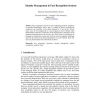Free Online Productivity Tools
i2Speak
i2Symbol
i2OCR
iTex2Img
iWeb2Print
iWeb2Shot
i2Type
iPdf2Split
iPdf2Merge
i2Bopomofo
i2Arabic
i2Style
i2Image
i2PDF
iLatex2Rtf
Sci2ools
BIOID
2008
2008
Identity Management in Face Recognition Systems
Face recognition is one of the most challenging biometric modalities for personal identification. This is due to a number of factors, including the complexity and variability of the signal captured by a face device. Several issues incur in the management of a face template as user's identity. Data dimensionality reduction, compactness of the representation, uniqueness of the template and ageing effects, are just but a few of the issues to be addressed. In this paper we present the current state of the art in face recognition technology and how this related to the proper management of a user's identity. Some real cases are presented and some conclusions are drawn.
| Added | 12 Oct 2010 |
| Updated | 12 Oct 2010 |
| Type | Conference |
| Year | 2008 |
| Where | BIOID |
| Authors | Massimo Tistarelli, Enrico Grosso |
Comments (0)

